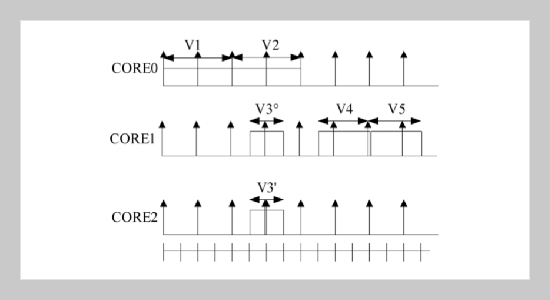REFERENCES
- [1] Chang, C. W., Chen, J. J., Kuo, T. W., et al. “Real-time Task Scheduling on Island-based Multi-core Platforms,” IEEE Transactions on Parallel &Distributed Systems, Vol. 26, No. 2, p. 1 (2014). doi: 10.1109/TPDS.2013. 2297308
- [2] Bell, P. C. and Wong, P. W. H., “Multiprocessor Speed Scaling for Jobs with Arbitrary Sizes and Deadlines,” Journal of Combinatorial Optimization, Vol. 29, No. 4, pp. 739�749 (2015). doi: 10.1007/s10878-013-9618-8
- [3] Meier, H. E. M., Döscher, R. and Faxén, T., “A Multiprocessor Coupled Ice-ocean Model for the BalticSea: Application to Salt Inflow,” Journal of Geophysical Research Oceans, Vol. 108, No. C8, pp. 343�367 (2015). doi: 10.1029/2000JC000521
- [4] Abdel All, M., Hassan, H. M., Hamdy, M., et al., “Design and Implementation of Application-specific Instruction-set Processor Design for High-throughput Multi-standard Wireless Orthogonal Frequency Division Multiplexing Baseband Processor,” Iet Circuits, Devices & Systems, Vol. 9, No. 3, pp. 191�203 (2015). doi: 10.1049/iet-cds.2014.0046
- [5] Ingham, M. D., Rasmussen, R. D., Bennett, M. B., et al., “Engineering Complex Embedded Systems with State Analysis and the Mission Data System,” Journal of Aerospace Computing Information & Communication, Vol. 2, No. 12, pp. 507�536 (2015). doi: 10.2514/ 1.15265
- [6] Lin, C. C., Chang, C. J., Syu, Y. C., et al., “An Energyefficient Task Scheduler for Multi-core Platforms with Per-core DVFS Based on Task Characteristics//Brazilian Conference on Intelligent Systems,” IEEE Computer Society, pp. 381�390 (2014). doi: 10.1109/ICPP. 2014.47
- [7] Chang, C. W., Chen, J. J., Kuo, T. W., et al., “Real-time Task Scheduling on Island-based Multi-core Platforms,” IEEE Transactions on Parallel &Distributed Systems, Vol. 26, No. 2, pp. 538�550 (2015). doi: 10.1109/ TPDS.2013.2297308
- [8] Meng, X. F. and Zhang, X. Y., “Parallel Task Scheduling Strategy with Multi-objective Constraints in P2P,” Computer Integrated Manufacturing Systems, Vol. 14, No. 4, pp. 761�766 (2008).
- [9] Xu, T., Li, P. and Sundareswaran, S., “Decoupling Capacitance Design Strategies for Power Delivery Networks with Power Gating,” ACM Transactions on Design Automation of Electronic Systems, Vol. 20, No. 3, pp. 1�30 (2015). doi: 10.1145/2700825
- [10] Saifullah, A., Agrawal, K., Lu, C., et al., “Multi-core Real-time Scheduling for Generalized Parallel Task Models,” Real-Time Systems, Vol. 49, No. 4, pp. 217� 226 (2013). doi: 10.1007/s11241-012-9166-9
- [11] Porto, S. C. S. and Ribeiro, C. C., “A Tabu Search Approach to Task Scheduling on Heterogeneous Processors under Precedence Constraints,” International Journal of High Speed Computing, Vol. 7, No. 1, pp. 45�71 (2012). doi: 10.1142/S012905339500004X
- [12] Sheikh, H. F., Ahmad, I., Wang, Z., et al., “An Overview and Classification of Thermal-aware Scheduling Techniques for Multi-core Processing Systems,” Sustainable Computing Informatics & Systems, Vol. 2, No. 3, pp. 151�169 (2012). doi: 10.1016/j.suscom. 2011.06.005
- [13] Jahn, J., Pagani, S., Kobbe, S., et al., “Runtime Resource Allocation for SoftwarePipelines,”ACMTransactions on Parallel Computing, Vol. 2, No. 1, pp. 1�23 (2015). doi: 10.1145/2742347
- [14] Min, C. and Eom, Y. I., “Dynamic Scheduling of Irregular Stream Programs toward Many-core Scalability,” IEEE Transactions on Parallel & Distributed Systems, Vol. 26, No. 6, pp. 1594�1607 (2015). doi: 10.1109/TPDS.2014.2325833
- [15] Wang, Y., Li, K., Chen, H., et al., “Energy-aware Data Allocation and Task Scheduling on Heterogeneous Multiprocessor SystemswithTimeConstraints,” IEEE Transactions on Emerging Topics in Computing, Vol. 2, No. 2, pp. 134�148 (2014). doi: 10.1109/TETC. 2014.2300632
- [16] Zhang, X., Chen, L. and Wang, M., “Efficient Parallel Processing of Distance Join Queries Over Distributed Graphs,” Knowledge & Data Engineering IEEE Transactions on, Vol. 27, No. 3, pp. 740�754 (2015). doi: 10.1109/TKDE.2014.2345383
- [17] Wang, T., Ji, Z., Sun, Q., et al., “Interactive Multi-label Image Segmentation via Robust Multi-layer Graph Constraints,” IEEE Transactions on Multimedia, Vol. 18, No. 12, pp. 2358�2371 (2016). doi: 10.1109/TMM. 2016.2600441
- [18] Diaz, L., Gonzalez, E., Villar, E., et al., “VIPPE, Parallel Simulation and Performance Analysis of Multicore Embedded Systems on Multi-core Platforms,” Design of Circuits and Integrated Circuits (DCIS), 2014 Conference on. IEEE, pp. 1�7 (2015). doi: 10. 1109/DCIS.2014.7035584
- [19] Chang, C. W., Chen, J. J., Kuo, T. W., et al., “Real-time Task Scheduling on Island-based Multi-core Platforms,” Parallel &Distributed Systems IEEE Transactions on, Vol. 26, No. 2, pp. 538�550 (2015). doi: 10.1109/ TPDS.2013.2297308
- [20] Mingas, G. and Bouganis, C. S., “Population-based MCMC on Multi-core CPUs, GPUs and FPGAs,” IEEE Transactions on Computers, Vol. 65, No. 4, pp. 1283�1296 (2016). doi: 10.1109/TC.2015.2439256
- [21] Mcintoshsmith, S., Price, J., Sessions, R. B., et al., “High Performance in Silico Virtual Drug Screening on Many-core Processors,” International Journal of High Performance Computing Applications, Vol. 29, No. 2, pp. 119�134 (2015). doi: 10.1177/1094342014 528252
- [22] Zhong, Z., Rychkov, V. and Lastovetsky, A., “Data Partitioning on Multicore and Multi-GPU Platforms Using Functional Performance Models,” IEEE Transactions on Computers, Vol. 64, No. 9, pp. 2506�2518 (2015). doi: 10.1109/TC.2014.2375202
- [23] Li, Y., Métivier, L., Brossier, R., et al., “2D and 3D Frequency-domain Elastic Wave Modeling in Complex Media with a Parallel Iterative Solver,” Geophysics, Vol. 80, No. 3, pp. T101�T118 (2015). doi: 10. 1190/geo2014-0480.1
- [24] Olszewski, P., “Genetic Optimization and Experimental Verification of Complex Parallel Pumping Station with Centrifugal Pumps,” Applied Energy, Vol. 178, pp. 527�539 (2016). doi: 10.1016/j.apenergy.2016.06.084
- [25] Ingargiola, A., Lerner, E., Chung, S. Y., et al., “A Multispot Confocal Platform for High-throughput Freely Diffusing Single-molecule FRET Studies,” Biophysical Journal, Vol. 110, No. 3, pp. 194a�195a (2016). doi: 10.1016/j.bpj.2015.11.1084
















